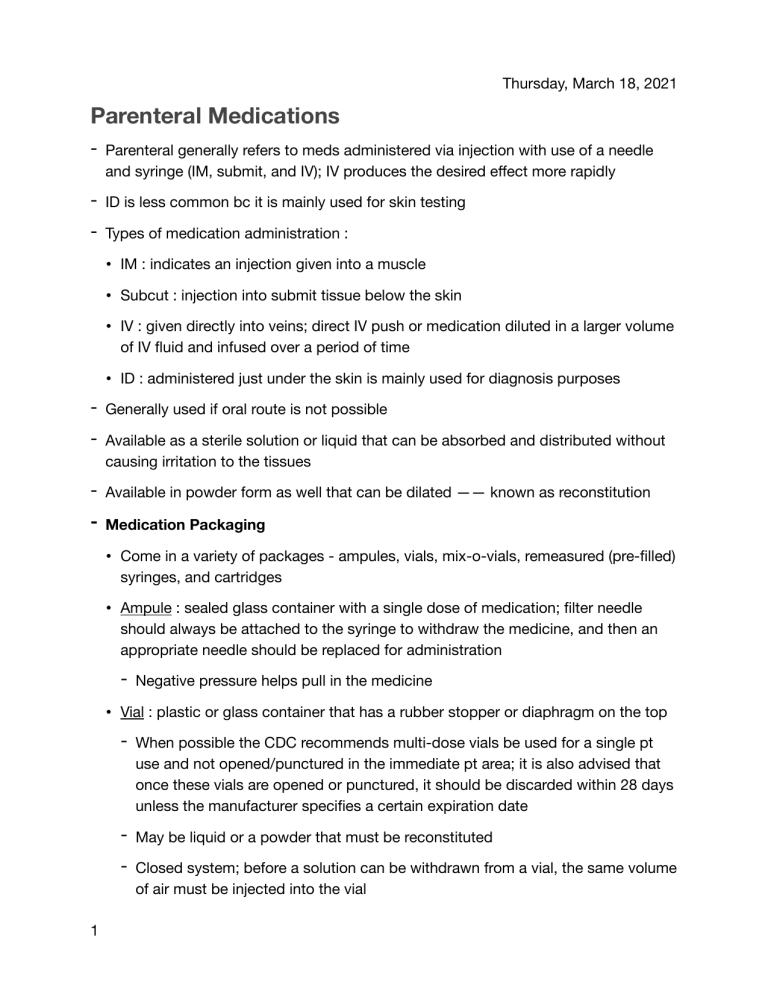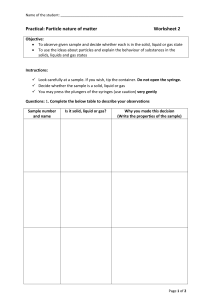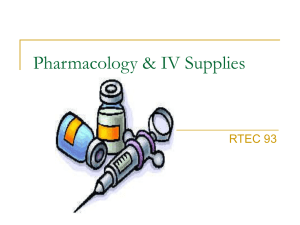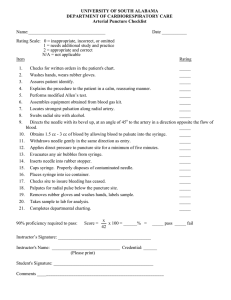
Thursday, March 18, 2021 Parenteral Medications - Parenteral generally refers to meds administered via injection with use of a needle and syringe (IM, submit, and IV); IV produces the desired e ect more rapidly - ID is less common bc it is mainly used for skin testing - Types of medication administration : • IM : indicates an injection given into a muscle • Subcut : injection into submit tissue below the skin • IV : given directly into veins; direct IV push or medication diluted in a larger volume of IV uid and infused over a period of time • ID : administered just under the skin is mainly used for diagnosis purposes - Generally used if oral route is not possible - Available as a sterile solution or liquid that can be absorbed and distributed without causing irritation to the tissues - Available in powder form as well that can be dilated —— known as reconstitution - Medication Packaging • Come in a variety of packages - ampules, vials, mix-o-vials, remeasured (pre- lled) syringes, and cartridges • Ampule : sealed glass container with a single dose of medication; lter needle should always be attached to the syringe to withdraw the medicine, and then an appropriate needle should be replaced for administration - Negative pressure helps pull in the medicine • Vial : plastic or glass container that has a rubber stopper or diaphragm on the top - When possible the CDC recommends multi-dose vials be used for a single pt use and not opened/punctured in the immediate pt area; it is also advised that once these vials are opened or punctured, it should be discarded within 28 days unless the manufacturer speci es a certain expiration date - May be liquid or a powder that must be reconstituted - Closed system; before a solution can be withdrawn from a vial, the same volume of air must be injected into the vial fi fi ff fi fl 1 Thursday, March 18, 2021 • For large volumes of solution to be withdrawn, a small volume of air is required to initiate the ow of medication • Mix-O-Vial : some meds come in these which have two compartments separated by a rubber stopper… too contains sterile liquid (diluent) while the bottom contains powdered meds • With pressure at the top, the rubber stopper that operates the meds and liquid is released allowing the meds to be mixed, dissolving the medication • Cartridge : some meds are packed in a re lled glass or plastic container; clearly marked, indicating the amount of meds in it; contains SINGLE dose - Certain ones require a special holder called a tubex or carpuject to release the meds from the cartridge - The white portion on the end can also be removed, exposing a rubber stopper in which a needle can be interred to remove calculated amounts - Discard unused medication with another nurse present • Pro led syringe (remeasured) : comes prepared for administration in a surging, with the needle attached or without a needle attached - Single-dose - Amount desired is calculated and excess is disposed of - epipen.. insulin are examples - Syringes • Have di erent capacities and speci c calibrations • Disposable and designed for one time use • Have three parts : - Barrel - outer calibrated portion that holds the medication; has markings on the outer portion - Plunger - inner device that is moved backward to withdraw and measure medication and is pushed to eject the meds from the syringe; ts into the barrel - Tip - end of the syringe that holds the needle; the needle slops on the tip or can be twisted and locked in place which prevents inadvertent removal of the needle fi fi fi fl ff fi 2 Thursday, March 18, 2021 • Needle size and diameter is chosen based on the client’s size, the type of tissue being injected into, and the viscosity of the meds to be injected…. Some also come with a needle attached that cannot be detached fro. Th syringe • Safety Needles and Needle-less Syringe - Needle stick prevention is the ONLY way to prevent transmission of blood-borne pathogens form contaminated needles - You should not recap a needle after use - Special equipment has been developed such as syringes with a sheath or guard that covers the needle after it is withdrawn from the skin, thereby decreasing chance of injury - The safety glide syringe has also been created which contains a protective needle guard that can be activated nay a single nger to cover and seal the needle after injection - Always activate the safety device following admin of an injection • Types of Syringes - Hypodermic syringes :syringe with a needle; 0.5 mL to 60 mL+ • Calibrated or marked In mL but hold varying capacities - Small syringes : 3mL syringe is used for the admin that is more than 1 mL; decimal numbers are used to express dosages • Most syringes have fraction increments on them.. but some indicate 0.5, 1.5 mL, etc. instead of fractions • The use of decimals on a syringe correlates with the use of decimals in the metric system, so a dosage should be stated as mL - Larger syringes : 10 mL, 20 mL, 50 mL+ • It is important to note that mL is correct, not cc, bc it is a treasure of volume. Although both are used interchangeably at times by others, they are NOT the same. • When measuring the amount of medication in a syringe, measure dose at the forward edge of the plunger head fi 3 Thursday, March 18, 2021 • Because small capacity syringes are used most often to administer meds, it is very important to know how to read them to withdraw amounts accurately - Large-Capacity Syringes • The largest hypodermics (5, 6, 10, and 12 mL) are used when volumes larger than 3 mL are desired; calibrated in increments of fths of a militia (0.2 mL) with the whole numbers indicated by long lines • Used to measure whole numbers of mL as opposed to smaller units such as a tenth of a mL • Commonly used to prepare meds for IV administration, thus are referred to as IV syringes • The LARGER the syringe, the LARGER the calibration - Tuberculin Syringe • Narrow syringe that has a capacity of 0.5 mL or 1 mL, with 1 mL used most often • Volume can be measured on mL scale; calibrated in hundredths (0.01 mL) and tenths (0.1 mL) of a mL… lines are closer together • Used to accurately measure meds given in very small volumes and is often used in peds and for diagnostic procedures as well as some vaccines • Dosages less than 5 mL should be measured with syringe to make certain that the correct dosage is given • Insulin syringes are used for submit injection of insulin and are calibrated in units rather than mL - Insulin is measured in units and always ordered in units - Calibrated for admin of standard U-100 insulin and abbreviated as “U-100” - Should not be used for admin of non-standard strengths of insulin, such s U-500.. in such a case to avoid errors the number of units and volume in mL of ordered dosage should be included for administration - Available in three sizes : 100, 50, and 30 fi 4 Thursday, March 18, 2021 • 100 unit (1mL) standard insulin syringe - calibrated in 2-unit increments; odd number of units would have to be measured between the even calibrations • 50 unit (0.5 mL) Lo-Dose insulin syringe - designed to deliver low doses of insulin with greater accuracy; calibrated in 1-unit increments to administer doses of 50mL or less • 30 unit (0.3 mL) Lo-Dose insulin syringe - designed to deliver low doses of insulin with greater accuracy; calibrated in 1-unit increments to administer doses of 30mL or less; used in peds primarily - Lo-Dose have an enlarged scale and are thus easier to read - Measurement of dosages that are approximate / in bt lines should be avoided - Second type of 100-U insulin syringe : dual-scale… calibrated in 2-unit increments with a scale of even-numbered 2-unit increments on one side • Calibrated on the opposite side In odd-numbered 2-unit increments - ALL insulin dosages should be CHECKED by another nurse before administration - No detachable needle - Insulin and tuberculin syringes are DIFFERENT - Reading Parenteral Labels • Contains total volume of container and dosage strength expressed in mL, similar to oral meds - Medications Labeled in Percentage Strengths • Meds that are labeled as percentage solutions give info such as percentage of the solution and the total volume of the vial or ampule , but metric units are generally still shown on the label - Solutions Expressed in Ratio Strength • Medication commonly given in ratio strength is epinephrine • Include metric measures as well and are often ordered by the number of mL 5 Thursday, March 18, 2021 • Express the number of grams of meds per total mLs of solution - Parenteral Medications Measured in Units • Some meds measured in units for parenteral admin are her pain, Pitocin, insulin, and penicillin indicating how Many units per mL • Units measure a medication in term of its action - Parenteral Medications in MEq • Potassium and sodiu bicarbonate are examples • MEq are speci c measurements that have no conversion to another system and are speci c to the meds used; used to measure electrolytes and the ionic activity of a me • Also de ned as an expression of the number of grams of a med contained in 1 mL of a normal solution - Calculating Parenteral Dosages • Parenteral dosages can be calculated by using the same methods used to computer oral dosages • Guidelines for Calculating Parenteral Dosages - To calculate parenteral dosages, convert if necessary, THINK, and calculate using one of the methods presented - Calculate dosages and prepare injectable dosages using the following guidelines : • The 3mL syringe is calibrated in 0.1 mL increments; round mLs to the nearest tenth to measure in a 3mL syringe.. NEVER ROUND TO A WHOLE UNIT only round to tenths place • The 1 mL (tuberculin) is calibrated in 0.001 mL increments. If math is not to hundredths place, round to hundredths place • Large syringes (5, 6, 10, and 12 mL) are calibrated in 0.2 mL increments; dosages are also expressed to the nearest tenth • Dosages administered should be measured in mLs, and the answer should be labeled accordingly • Standard U-100 insulin is administered and measured in units fi fi fi 6 Thursday, March 18, 2021 - For injectable meds, is it recommended that when the amount exceeds the amount that can be administered in a single site, dived the amount into two injections… the condition of the client, site selected, and absorption and consistency of the meds must be considered • Client may not be able to tolerate max dosage volumes - The max volume to administer in a single IM site : (less common than in the past) • Adult 3mL (1mL for deltoid) • 6-12 2mL • 0-5 1mL - The max volume to administer in a single subcut : • Adult 1 mL - The max volume to administer in IV • Injectable solutions added to an IV solution may have a volume greater than 5 ml - Calculating Injectable Medications According to the Syringe • Check everything is in the same system and unit of measure • Think critically and estimate what the logical volume to administer should be • Calculate • Consider type of syringe to be used … the cardinal rule should always be that the dosage must be able to be measured accurately in the syringe being used - Calculating Dosages for Medications in Units • Use the same steps as with other parenteral meds • Some dosages, such as heparin, are administered with tuberculin syringe rather than hypodermic syringe… heparin is NEVER rounded o bc of its e ects; EXACT is given • No conversion is required. No conversion exists for units. • Units are not abbreviated to avoid confusion ff ff 7 Thursday, March 18, 2021 - Mixing Medications in the Same Syringe • Two meds may be mixed in the same syringe if they are compatible with each tore and the total amount does not exceed amount that can be safely given in a site • Calculate to nearest tenth for each individual med then add results to nd total volume combined and administered fi 8



